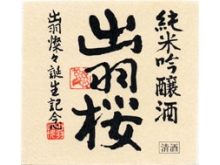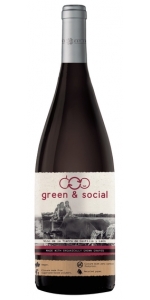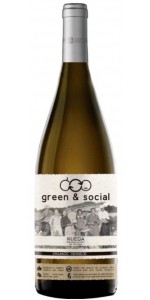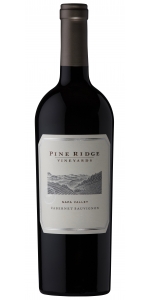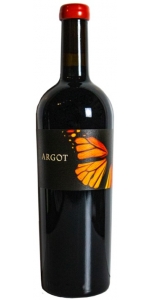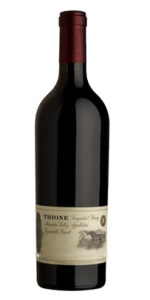Dewasansan Green Ridge (720ml)
| Country: | Japan |
| Region: | Yamagata |
| Winery: | Dewazakura Brewing Company |
| Grape Type: | Dewasansan (Sake) |
| Vintage: | NV |
| Bottle Size: | 720 ml |
Green & Social Rueda Organic Tempranillo is made from 100 percent Tempranillo.
The launch of green & social is a step forward in pursuit of the sustainability by Cuatro Rayas and the starting point of new environmental initiatives in support of the social economy that the Cooperative launched. Lightweight recycled glass to reduce emissions. Aluminum capsule free of plastics and 100% recyclable. Sugar cane cap with zero carbon footprint. The Green and Social Organic Tempranillo has a bright and clean, mid-depth ruby red color and purple hue. Intense aroma with hints of ripe berries. Soft and velvety on the plate, perfect balance between tannins and acidity, round and long finish.
Green & Social Rueda Organic Verdejo is made from 100 percent Verdejo.
The launch of green & social is a step forward in pursuit of the sustainability by Cuatro Rayas and the starting point of new environmental initiatives in support of the social economy that the Cooperative launched. Lightweight recycled glass to reduce emissions. Aluminum capsule free of plastics and 100% recyclable. Sugar cane cap with zero carbon footprint.
Green and social Rueda offers a straw yellow color with bright green hues and exhibits fresh, citrus fruit and balsamic aromas that are typical of the Verdejo variety. Its simplicity and purity find a dynamic and seductive path between fresh flavors, finesse, and minerality. It is a fresh and crisp wine.
Green & Social Rueda Organic Verdejo is made from 100 percent Verdejo.
The launch of green & social is a step forward in pursuit of the sustainability by Cuatro Rayas and the starting point of new environmental initiatives in support of the social economy that the Cooperative launched. Lightweight recycled glass to reduce emissions. Aluminum capsule free of plastics and 100% recyclable. Sugar cane cap with zero carbon footprint.
Green and social Rueda offers a straw yellow color with bright green hues and exhibits fresh, citrus fruit and balsamic aromas that are typical of the Verdejo variety. Its simplicity and purity find a dynamic and seductive path between fresh flavors, finesse, and minerality. It is a fresh and crisp wine.
Pine Ridge Napa Valley Cabernet Sauvignon is made from 80% Cabernet Sauvignon, 8% Merlot, 7% Petite Sirah, 5% Malbec.
While admiring the cranberry red hue, forward fruit aromatics of black cherry and cassis begin to make your mouth water before the first sip! On the palate, juicy notes of blueberry compote and cherry cordial meld seamlessly with hints of cinnamon and cream soda. The wine methodically transitions from the bright, round entry through the viscous midpalate and onto a broad-shouldered finish. This is where hints of clove, graham cracker and toasted marshmallow are juxtaposed with those of dark roast coffee and Bing cherry. This wine can be enjoyed now but will benefit from another 10 to 20 years of bottle age.
It pairs beautifully with a vegetarian chili and cornbread slathered in a generous helping of sweet cream butter.
Review:
Alluring nuances of rose petal, tobacco and cinnamon lead into a ripe, chocolaty palate of black cherries, cocoa and raspberries as a soft, velvety texture achieves a very smooth mouthfeel.
-Wine Enthusiast 93 Points
A dramatic, ridgetop landscape — rising 1500 feet above Lake Hennessey, staring west over Pritchard Hill — persistently influenced by a push/pull draw between The Valley’s floor and Lake Berryessa. This wild, untamed, eastern frontier of Napa Valley, produces singular, terroir-driven wines of captivating beauty, power and lift. An unseasonably wet and cool springtime produced significant shatter at Sage Ridge in 2019, reducing our yields by 50%, leading to a particularly flamboyant edition of this wine.
An incomparable expression of Cabernet Sauvignon — massively pure red fruit character, delivered on a ribbon of ultra-suave tannins and gorgeously seductive high tones. The palate never relents its come-hither posture. Aromatically, puts forth an intriguing botanical complexity that is unmistakably site-specific. As our experience with this one-of-a-kind terroir deepens, we remain endlessly excited for the potential of these unique ridgetop vineyards. Get your hands on a bottle and pull the cork…a wine built for immense near-term gratification.
Review:
"Deep garnet-purple colored, the 2019 Cabernet Sauvignon Sage Ridge Vineyard opens with open-knit notes of plum preserves, baked blackberries and boysenberry jam, leading to a core of crème de cassis, mocha, camphor and Indian spices with a touch of unsmoked cigars. The palate is full-bodied, concentrated and dense with black fruit preserves, framed by soft tannins and seamless freshness, finishing very long and very spicy. Only 75 cases were made. - Lisa Perrotti-Brown"
- Robert Parker's Wine Advocate (November 2021), 95 pts
Trione Zinfandel Flatridge Ranch is made from 100 percent Zinfandel.
Aromas of briarwood and pipe tobacco give way to blackberry pie, toasted macaroons and plums. The wine is velvety, supple and rich with a long, satisfying finish. This Zinfandel, a Sonoma County classic, will continue to age for many years to come.
Flatridge Ranch is a secluded parcel in the Coastal mountain range, west of the Rockpile AVA. Here the Trione family planted a 10 acre vineyard in 2008. The vines are a unique Zinfandel selection called Saint Peter’s Church, whose provenance is a 100-year-old block in Cloverdale, a small town north of our Geyserville winery. The 2013 vintage was a perfect growing season.
Cases produced: 575
Winemaking: We fermented the grapes in small, open top fermenters, hand plunging the cap three-four times daily. The wine aged 18 months in American oak barrels, 40% new.
Sake Dewasansan Green Ridge has a floral nose and mellow fruity flavor, “Dewasansan” is a rewarding choice for wine drinkers new to the world of sake. It has a wholesome freshness, a green apple tartness and a refreshing finish. The delightful bouquet comes from Association No. 10 yeast, and the mellow rice taste from “Dewa 33,” a new rice strain developed in Yamagata Prefecture. The perfect sake for tuna sashimi and grilled seafood of all kinds.
Awards: Gold Medal, Ginjo class, 2002 U.S. National Sake Appraisal
Rice Variety: Dewasansan
Polishing Ratio: 50%
Alcohol Percentage: 15.8%
Sake Meter Value: +4.0
Acidity: 1.4
Yeast Type: Yamagata KA
Dewazakura Brewing Company
Many sake enthusiasts are surprised to learn that twenty-five years ago ginjo labels were hard to find in Japan. In those days, people were still drinking the cloyingly sweet sakes the breweries had been churning out since the ’50s; no one thought that customers would actually pay more for the quality ginjo and daiginjo sakes brewed in limited amounts for competitions.
In 1981, Dewazakura Brewing Company changed that with the release of "Oka," an affordably priced ginjo label with a polishing ratio of 50 percent and a lovely floral aroma. It was light, crisp and delightful. It was made to be drunk cold. Soon other breweries introduced their own ginjo labels. And so began one of the most creative periods in the history of sake, earning for Dewazakura the admiration and respect of even its most ardent competitors.
What made the brewery stand out was a drive for innovation. Dewazakura was not a wealthy brewery, or a long-established one, but they were open to change. When the opportunity arose in the years after the war to invite research technicians in from the National Research Institute of Brewing, they jumped at the chance. Drawing on the knowledge and skill of Hideo Abe, a former Institute research advisor, they put new ideas into practice without hesitation.
By 1991, Dewazakura had perfected its cold storage technique, aging freshly pressed sake at 28 degrees Fahrenheit to keep it as aromatic and flavorful as possible until bottling. In 1996 it introduced "Dewasansan," brewed from a new Yamagata rice strain of the same name, another hit which opened the way for other prefectures to introduce highly specific regional labels. This year, for the first time in history, Yamagata breweries received more gold medals than any other prefecture at the 2004 Japan National Sake Appraisal, an achievement due in no small measure to the pioneering efforts of the Dewazakura Brewing Company.
- back
Pernot Belicard Batard Montrachet Grand Cru is made from 100 percent Chardonnay.
Aromas of white peach, white apple, with a beautiful minerality. Also lighty salty, chalky aromas and some bread and brioche flavors and a hint of vanilla.
Poultry with cream based sauces, French cheese, like camembert, but not too strong, also seafood and fish.
Mas Redonne Tournier Bandol Luisa Jeanne is made from 95% Mourvedre and 5% Syrah.
The wine takes its name from a goddess, Luisa Jeanne. It has a deep red color with dark brick hues, a very intense and complex nose with strong sensations of dark fruit, compote, spice, earth and garrigue, with a minty touch. Palate intense, complex and silky, full and opulent with olfactive sensations and a slightly mineral saline aftertaste accompanied by rich but ripe tannins wrapped in a fruity robe. Approachable, long, harmonious, elegant.
Late manual harvesting of left grapes, their selection according to ripeness, harvesting parcel by parcel, variety by variety, separate vinification. Long fermentation with natural yeasts to oxygenate the must, gentle extraction of color and tannins, decanting and dipping of the matoline cap to absorb the tannins and make the wine silky and expressive. Aged for 18 months in old foudres.
A gastronomic wine for major occasions, ideal for red meat, game, charcuterie, cheese, chocolate and Provençal cuisine.
The wine takes its name from a goddess, Luisa Jeanne. It has a deep red color with dark brick hues, a very intense and complex nose with strong sensations of dark fruit, compote, spice, earth and garrigue, with a minty touch. Palate intense, complex and silky, full and opulent with olfactive sensations and a slightly mineral saline aftertaste accompanied by rich but ripe tannins wrapped in a fruity robe. Approachable, long, harmonious, elegant.

